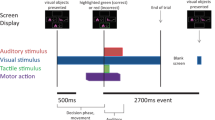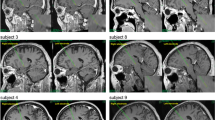Summary
In order to investigate the influence of basal ganglia and cerebellar involvement on the preparatory state of the cerebral cortex for voluntary movement, the cortical potential preceding finger movement was studied in 20 patients with Parkinson's disease and 20 patients with cerebellar ataxia. Readiness potential (RP) was abnormal in 90% of the Parkinson group and in 55% of the cerebellar ataxia group. The most frequent abnormality was a depressed amplitude and earlier onset of RP in both groups. The most remarkable finding in the present study was the complete absence of RP with dyssynergia cerebellaris myoclonica (presumed Ramsay Hunt syndrome) whereas normal RP was obtained with cerebellar cortical degeneration. In addition, RP was absent or severely depressed in patients with a unilateral vascular lesion of the midbrain (Benedikt's syndrome) and in patients with Parkinson's disease who underwent unilateral intermedioventral (Vim) thalamotomy. These facts suggest a possible important role of the dentatorubro-thalamic or dentatothalamic pathway in the physiogenesis of RP.
Zusammenfassung
Kortikale Potentiale vor der willkürlichen Fingerbewegung wurden bei 20 Patienten mit Parkinsonscher Krankheit und bei 20 mit cerebellärer Ataxie studiert, um den Effekt der Stammganglien- und Kleinhirnläsion auf den Bereitschaftszustand der Großhirnrinde für Willkürbewegungen zu untersuchen. Das Bereitschaftspotential war abnorm bei 90% der Parkinsonpatienten und bei 55% der Patienten mit Ataxie. Die häufigste Abnormität war eine Depression und ein früherer Anstieg des Bereitschaftspotentials bei beiden Patientengruppen. Der bemerkenswerteste Befund war ein vollständiges Fehlen des Bereitschaftspotentials bei Patienten mit wahrscheinlicher Dyssynergia cerebellaris myoclonica (Ramsay Hunt Syndrom), während ein normales Bereitschaftspotential bei Patienten mit cerebellärer kortikaler Degeneration gefunden wurde. Das Bereitschaftspotential fehlte oder war auffallend niedrig bei Patienten mit einseitiger vaskulärer Mittelhirnläsion (Benedikt Syndrom) und bei Patienten mit Parkinsonscher Krankheit nach einseitiger Thalamotomie (Nukleus ventralis intermedius). Diese Befunde weisen auf eine wichtige Rolle der dentato-rubro-thalamischen oder dentato-thalamischen Bahn in der Pathogenese des Bereitschaftspotentials hin.
Similar content being viewed by others
References
Arezzo, J., Vaughan, H. G., Jr., Koss, B.: Relationship of neuronal activity to gross movement-related potentials in monkey pre- and postcentral cortex. Brain Res. 132, 362–369 (1977)
Deecke, L., Becker, W., Grözinger, B., Scheid, P., Kornhuber, H. H.: Human brain potentials preceding voluntary limb movement. Electroenceph. clin. Neurophysiol. 33 (Suppl.), 87–94 (1973)
Deecke, L., Englitz, H.-G., Kornhuber, H. H., Schmitt, G.: Movement-related potentials in basal ganglia disease. J. Postgrad. Med. 21 (Suppl. 1), 3–4 (1975)
Deecke, L., Grözinger, B., Kornhuber, H. H.: Voluntary finger movement in man: Cerebral potentials and theory. Biol. Cybernetics 23, 99–119 (1976)
Deecke, L., Kornhuber, H. H., Schmitt, G.: Bereitschaftspotential in Parkinson patients. Pflügers Arch. 343 (Suppl.), R75 (1973)
Deecke, L., Scheid, P., Kornhuber, H. H.: Distribution of readiness potential, pre-motion positivity, and motor potential of the human cerebral cortex preceding voluntary finger movements. Exp. Brain Res. 7, 158–168 (1969)
DeLong, M. R., Strick, P. L.: Relation of basal ganglia, cerebellum, and motor cortex units to ramp and ballistic limb movements. Brain Res. 71, 327–335 (1974)
Hunt, J. R.: Dyssynergia cerebellaris myoclonica—primary atrophy of the dentate system: A contribution to the pathology and symptomatology of the cerebellum. Brain 44, 490–538 (1921)
Kornhuber, H. H.: Cerebral cortex, cerebellum, and basal ganglia: an introduction to their motor functions. In Schmitt, F. O. (ed.): The Neurosciences, pp. 267–280. III. Study Program. Cambridge, Mass.: MIT Press 1974
Kornhuber, H. H., Deecke, L.: Hirnpotentialänderungen bei Willkürbewegungen und passiven Bewegungen des Menschen: Bereitschaftspotential und reafferente Potentiale. Pflügers Arch. 284, 1–17 (1965)
Schmidt, E. M., Jost, R. G., Davis, K. K.: Cortical cell discharge patterns in anticipation of a trained movement. Brain Res. 75, 309–311 (1974)
Shibasaki, H.: Movement-associated cortical potentials in unilateral cerebral lesions. J. Neurol. 209, 189–198 (1975)
Shibasaki, H.: Basic and clinical studies on the movement-related cortical potentials. IV. Topography of movement-related cortical potentials. Jap. J. EEG EMG 4, 157–164 (1976)
Shibasaki, H., Kato, M.: Movement-associated cortical potentials with unilateral and bilateral simultaneous hand movement. J. Neurol. 208, 191–199 (1975)
Shibasaki, H., Yamashita, Y., Yoon, W.-Y.: Electroencephalographic study of myoclonus. Saishin Igaku 32, 236–247 (1977) (in Japanese)
Strick, P. L.: Activity of ventrolateral thalamic neurons during arm movement. J. Neurophysiol. 39, 1032–1044 (1976)
Tanji, J., Evarts, E. V.: Anticipatory activity of motor cortex neurons in relation to direction of an intended movement. J. Neurophysiol. 39, 1062–1068 (1976)
Thach, W. T.: Discharge of cerebellar neurons related to two maintained postures and two prompt movements. I. Nuclear cell output. J. Neurophysiol. 33, 527–536 (1970)
Timsit-Berthier, M., Delaunoy, J., Rousseau, J. C.: Slow potential changes in psychiatry. II. Motor potential. Electroenceph. clin. Neurophysiol. 35, 363–367 (1973)
Vaughan, H. G., Jr., Costa, L. D., Gilden, L., Schimmel, H.: Identification of sensory and motor components of cerebral activity in simple reaction time tasks. Proc. 73rd Conv. Amer. Psychol. Assoc. 1, 179–180 (1965)
Vaughan, H. G., Jr., Costa, L. D., Ritter, W.: Topography of the human motor potential. Electroenceph. clin. Neurophysiol. 25, 1–10 (1968)
Author information
Authors and Affiliations
Rights and permissions
About this article
Cite this article
Shibasaki, H., Shima, F. & Kuroiwa, Y. Clinical studies of the movement-related cortical potential (MP) and the relationship between the dentatorubrothalamic pathway and readiness potential (RP). J. Neurol. 219, 15–25 (1978). https://doi.org/10.1007/BF00313365
Received:
Issue Date:
DOI: https://doi.org/10.1007/BF00313365




